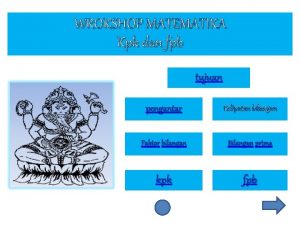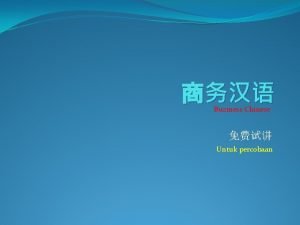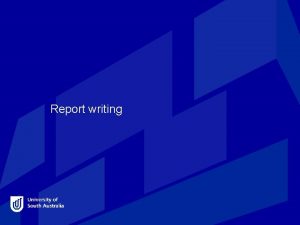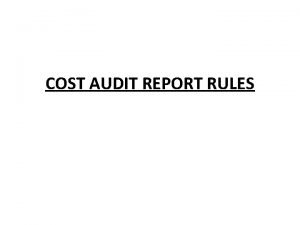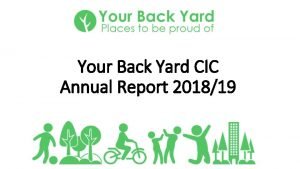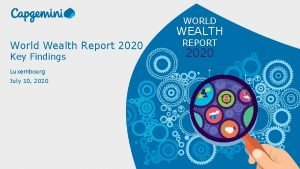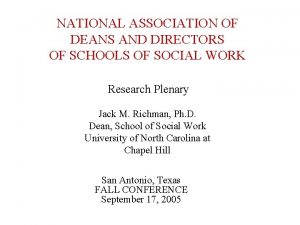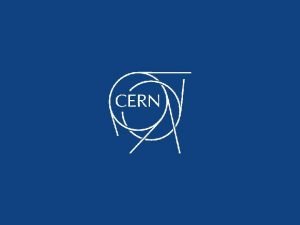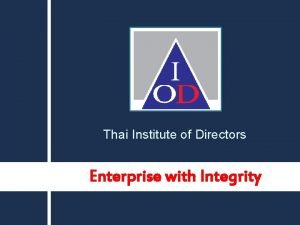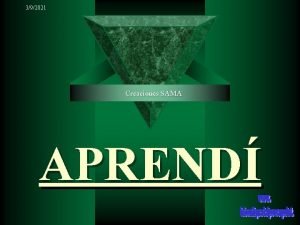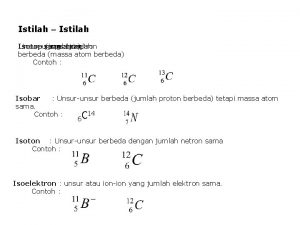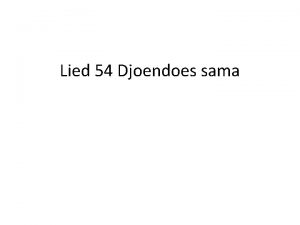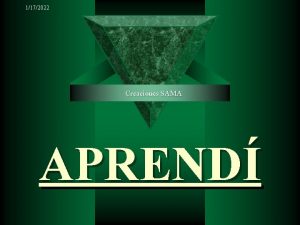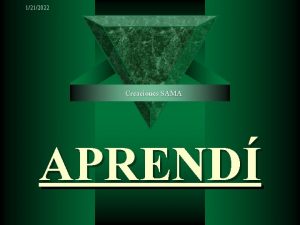Directors Report 2019 3 Contents Directors Report SAMA












- Slides: 12

Director’s Report 2019

3 Contents Directors Report SAMA Board Members General Manager’s report Committee Report Abridged Financial Report 2019 in Pictures 3 8 10 13 18 24

4 5 Dr Angelique Coetzee Director’s report B eginnings and endings always offer unique opportunities for introspection, reflection, and assessment. The ending of years and the starting of new years are one such opportunity. Not only does this offer context for events which have past, it provides honest and critical data on which to base future decisions. We might consider these reflections – be they personal or professional – luxuries sometimes borne from idle downtime. This approach, in our view, is incorrect and self-defeating. Instead, we would argue, these reflections are necessary and purposeful; they guide us forward, and can be useful if considered with a positive outcome in mind. This, then, is our task here. We offer reflection on the events of 2019, and provide the data with which you can make assessments. It is an important undertaking, one we do not take lightly. We see our role in doing so as essential to the continued well-being of SAMA because the information we impart is an honest account of the association the past 12 months, albeit in a summarised manner. As such what we provide here should serve to guide us on where we have been, we are going, and the challenges we face in getting there. Apart from providing this contextual background to our report, it is important to note that the feedback we present here on our activities is aimed at advancing the objectives of our association and, crucially, our part in addressing the needs of our members. This report covers high-level issues on which the Board provided input; operational issues are covered extensively in the Acting General Manager’s Report and contain more granular detail on specific activities, while the activities of various committees is attended to in different sections which follow. In October 2018 we were given the enormous honour of being elected to serve on the Board of SAMA. Dr Angelique Coetzee and Dr Mvuyisi Mzukwa were elected Chairperson and Vice-Chairperson respectively. We all remain humbled by the trust placed in us by our peers within the association, and we continue to serve at their pleasure. Our transition from the old Board to the new did not, however, transpire without complexities. In 2019 then General Manager, Dr Manny Thandrayen, opted to leave SAMA for personal reasons. Dr Thandrayen’s departure came at a crucial time. This is an important development because, as a new Board in 2019, most of us were new in these positions and our experiences in these roles proved to be a steep learning curve for many of us. But we needed to carry on regardless of our inexperience and the loss of key personnel. We were, and continue to be, grateful to have Dr Vusumuzi Nhlapho step into the breach as Acting General Manager in August following Dr Thandrayen’s departure. Dr Nhlapho assumed the role in addition to continuing his duties as the Head of the Private Practice Department at SAMA and he has performed both functions with exceptional professionalism, vision and tenacity. Regrettably in August, the Board accepted the resignation of two directors which came amid allegations of a breach of their duties as directors. Although both directors were given the opportunity to present their perspectives, they declined to do so on legal advice. The Board accepted their resignations on 15 August in compliance with its fiduciary obligations to the association. Ongoing investigations and legal proceedings will undoubtedly feature in the 2020 review as they have not, as yet, been concluded. A view looking back may perhaps best be served by reviewing events in chronological order but for the purposes of our report it is instructive to jump ahead somewhat to the happenings which occurred later in the year. We are, of course, referring to the issues surrounding the trade union. It is no secret that there were disputes within SAMA over the trade union, essentially relating to its constitutional independence and financial state. That the trade union did not meet the requirements of the Labour Relations Act (LRA) in terms of its own constitution, composition and management is a matter which raised the Board’s concerns. These issues are partly due to the fact that it has always been difficult to reconcile the uniqueness of SAMA with the rigidity of the LRA in so much as highly skilled and professional doctors stand in contrast to traditional trade unionists and do not have the time to conduct shop steward functions. Despite intensive efforts to address this problem through the SAMA Trade Union Task Team (SAMA TUTT) – which sought to establish a legitimate trade union leadership – ambivalence to the process (in both concluding elective processes as well as in attendance at meetings) meant no National Elective Congress could be held and, instead, a Membership Consultative Meeting was called for 31 August to 1 September. This “inauspicious” Membership Consultative Meeting led to the creation of the interim ad hoc Trade Union Committee (ICU), a body recognised by the SAMA Board. However, in spite of the creation of this body, the trade union still did not comply with its own constitution, nor with the requirements of the LRA. In late October 2019 the Registrar of the Labour Court placed the trade union under administration citing that there is currently no valid leadership within the trade union. SAMA supports this development and we continue to maintain our position that we act on behalf of all our members, both in the private as well as in the public sector. The ongoing processes relating to the administration of the trade union are likely to spill over into 2020, and we will reflect these developments as and when they occur and, we are sure, it will be another important part of the review prepared at the end of next year. Besides this important matter, there were other important issues the SAMA Board was seized with during the year which we wish to dwell on briefly. These included: u The criminalisation of medical errors u Health Professions Council of South Africa (HPCSA) u National Health Insurance (NHI) & Presidential Compact u SAMA Membership & CPD u Safety of healthcare workers at public institutions Criminalisation of medical errors In early December two medical specialists were arrested, charged and brought before court on charges of medical negligence. SAMA has taken great exception to the arrest of the doctors as criminal proceedings against doctors, specifically in relation to them appearing in court, do not require warrants of arrest but can be secured by summonses. In addition, a procedure-related death should be the subject of an inquest rather than a criminal investigation but the current processes of the HPCSA remain so dysfunctional that patients have no other recourse but to approach other authorities for relief. We remain concerned about these actions and the precedents they are likely to create. We continue to engage with various bodies and authorities on this issue with a view to determining a better way forward to handle these types of events when they occur.

6 7 VISION Tobe the leading and preferred membership organization advocating and supporting medical practitioners in South Africa. MISSION Being the custodians of a growing advocacy platformthat will unite, guide and support member medical doctors for the health of the nation. OURVALUES Member Driven Focused Engagement Empathy Collaboration Operational Excellence Inform&Educate Thought leadership Resourcefulness Consistency Accountability Agility &Responsiveness OUR MEMBER VALUE PROPOSITION Uniting and supporting doctors for the health of the nation. PILLAR 1 Grow Membership PILLAR 3 Enhanced Member Value PILLAR 2 Brand PILLAR 4 Strategic Partnerships OUR SOUL u u We believe we are the partner for a group of specialized individuals in society (the medical profession) who are there for society. They have an inherent need for belonging to a broader group with a stronger voice that would play a role in support in terms u of advocacy and engagement with various stakeholders in a difficult environment. u They are driven by a deep-rooted desire to bring about change and improve the lives and well-being of people. u They are in need for a vehicle to support that dream. HPCSA The HPCSA remains a problem for SAMA considering both the above example as well as the allegations of administrative irregularities and poor governance at the Council. Problems at the HPCSA identified years ago remain unresolved today. Poor communication to the public and practitioners, unfair processes in professional conduct inquires, and undue and unnecessary delays in processing applications led our chairperson, Dr Coetzee, to comment in late October that this was an outrageous situation and a sad state of affairs. For this reason SAMA has attended meetings aimed at establishing a separate Medical and Dental Board. This is an ongoing development of which we will shall keep you informed. NHI & Presidential Health Compact The Presidential Health Summit in July laid the basis for the Presidential Health Compact which seeks to improve the country’s healthcare system so that many more South Africans can access quality healthcare. SAMA was one of the participants to the summit and again committed itself and its members to realising this objective. In the context of NHI the objectives of the Presidential Health Compact are an important development but we remain concerned about some aspects of NHI going forward. In late November SAMA representatives presented our final submission on the 2019 NHI Bill to the Parliamentary Portfolio Committee on Health. We stressed that we have been and continue to be in support of the principles of Universal Health Coverage (UHC), and quality care for all within the South African healthcare system. However, we are not able to support to the Bill in its current format. Among the issues we raised in this regard are the contracting and payment mechanisms which have never been implemented in South Africa before, missing detail on quality care expectations, and our concern about a single fund to secure UHC for all South Africans. We also raised concerns about the amount of power the Bill places in the hands of the Minister of Health. We will monitor the unfolding of NHI, and we will continue to provide input as and when opportunities arise to do so. SAMA Membership & CPD SAMA membership remained stable throughout the year with the association ending 2019 with 16286 members, a decrease of 131 members from 2018. What was encouraging is the 20% increase in CPD applications received during the year which ended on 1617 applications. These trends indicate that we are fulfilling the needs of our members, providing them quality programmes and events for CPD points, and ensuring we meet the objectives of our association. SAMA’s Financial Performance SAMA’s financial statements had to be restated splitting revenue linked to SAMA NPC and the Trade Union in line with the latest court judgement which is currently before the courts. The Abridged Consolidated Financial Statements are presented in this Directors’ report. Some salient financial performance of SAMA are as follows: • Group Profitability – Group loss of R 18. 2 m (2018: Group Profit of R 46 m); • Company Profitability (Head Office) – Loss of R 4 m (2018: Loss of R 2. 5 m); • Membership Fees (excluding Trade Union) – R 31. 2 m(2018: R 24. 1 m); • Total Assets: Group – R 491 m (2018: R 474 m); Company (Head Office) – R 170 m (2018: R 168 m) It is the Board’s view that SAMA remains sustainable despite recent challenges and the strategy launched in 2019 is a launching pad for the Association’s sustainability going forward. Safety of healthcare workers at public institutions There have, sadly, been too many violent incidents involving healthcare workers at public institutions. These incidents include doctors being raped, shot, stabbed, physically attacked, and threatened with violence. Through the year we continued to express our anger and dismay at these incidents, and their continuation despite assurances from the National Department of Health as well as Provincial Departments of Health that security is being improved. We remain concerned that these incidents do not appear to be abating, and that the well-being of all healthcare workers (not only our members) is being compromised. We will continue to engage with all roleplayers with to ensure better security at these institutions, more consultation with managers on working conditions for doctors, and an overall improvement in the level of support provided to doctors to prevent such incidents from occurring. SAMA Strategy Despite numerous challenges experienced in 2019, the year culminated in the Board and Management undertaking a crucial forward looking strategic planning session. This was informed by a survey contacted on our membership base where we asked you to perform a “dipstick”assessment of your Association. This survey resulted in the development of SAMA’s new strategic focus, now termed as the SAMA house. More detailed on this critical strategy is contained in the General Manager’s report. Conclusion Our brief outline of activities and interests above will always be incomplete, given the space constraints of a document such as this. We believe, though, that we have given some insights into the key developments of SAMA during 2019, and that other submissions made will expound on areas not covered here. We have, for instance, not touched on the Strategic Plan 2020 -2024 and the four pillars on which that rests, which will be covered in in more depth in the Acting General Manager’s report. Other high-level local and international interactions and engagements by ourselves, other representatives of SAMA, and SAMA members are also not highlighted here as there have been too many to mention in this short space. We remain committed to the objectives of SAMA, and the fulfillment of our duties for the benefit of our members. Our driving principle as a Board will always be ensuring the interests, well-being, and professional recognition our members in private and public service is at the forefront of all our decisions. We value and respect the trust placed in us as a SAMA Board and we will continue to do our work diligently in delivering on the mandate entrusted to us. SAMA Board December 2019

8 Board members Front Row: Dr M. Mzukwa (V/Chair) Dr A. Coetzee (Chair) Prof H. M. Coovadia (President) 9 Back row: Dr M. van der Schyff, Prof M. Naidoo, Dr T. O. Sadiki, Dr M. Nodikida, Dr C. S. Sihlangu, Dr S. Toni, Dr M. N. Mabasa, Dr R. E. Ngwenya, Dr M. C. Human, Dr L. M. B. Majake

11 10 Acting General Manager’s Report – 2019 I n preparing this review of SAMA activities for 2019 it must be noted that I assumed the role of Acting General Manager in August, and much of the work this was done by my predecessor Dr Manny Thandrayen. I am thankful for the work he did before his departure and I want to acknowledge the contribution he made to SAMA before his leaving for personal reasons. This report, then, covers the period prior to my appointment and, naturally, the period thereafter. It is important for meto stress that the context of this report remains addressing the needs of staff, members, and other stakeholders who have interests in SAMA. It is crucial from a management perspective that these needs are met and that operationally SAMA is able to do so. A key aspect to realise this is to understand what these needs are and for this reason an important member survey was conducted from May to July to provide critical insights. The results of the survey were encouraging from the perspective that members in both the private and public sectors look to SAMA to be an influential voice for the medical profession in South Africa. This affirms our belief that doctors want us to be the conduits for their opinions, particularly in the national conversation on health matters. This finding inspires us to continue raising issues of importance to the profession which impact on doctors. It also raised several key areas in which we need a stronger focus and our commitment to ensuring we fulfill our mandate means we need to adapt to strengthen certain areas of our operation. An important outflow from the member survey was the realisation that communication – both internally and externally – remains a key function. With this in mind a monthly communique is being sent to all Branch Chairpersons highlighting important issues in which SAMA is involved. Additionally, communication through our various channels to doctors and specialists has increased in both frequency and content. Our external communication has also been ramped up with more and more interaction with the media on both traditional and social media platforms. While we are making inroads in our communication efforts, more can be done, and it remains a focus for the future. In addressing the issues highlighted through the member survey it became apparent that a new approach was necessary. In this regard we devised a better way of operating and managing ourselves and our members. We did have to reinvent ourselves, but we had to reimagine the way in which we currently work. From this realisation we developed and have begun implementing the SAMA 2020 -2024 Strategy. The Strategy rests on four pillars we believe are essential to the future prosperity of SAMA and its members. The four strategic pillars are: u Grow Membership u Brand Amplification u Enhance Member Value u Strategic Partnerships These four pillars represent what we want to achieve as much as they set out clearly what we believe are the cornerstones of our sustained existence. On these four pillars rests our member value proposition which is to unite and support doctors for the health of the nation. This proposition, in turn, underpins our three values which are to be member driven, to have influential advocacy, and to strive for operational excellence. These values inform our mission – where we are as a business, and our objectives – and our vision, where we desire to be in future. Our mission, therefore, based on our Strategy 2020 -204 is “to be the custodians of a growing advocacy platform that will unite, guide and support members for the health of the nation”, while our vision – where we want to be – “is to be the leading and preferred membership organisation advocating and supporting medical practitioners in South Africa”. Strategies are not new and the success of any document lies in its implementation, and we are aware of this imperative. However, in the few short months since its adoption by the Board, a marked difference can be noted in several of our activities. We are increasing our communication, there is a new-found sense of urgency among staff specifically in relation to dealing with members, and our interactions with outside stakeholders has seen a marked increase. But the new strategy has required a number of structural changes to ensure proper alignment with financial efficiencies. Of course our Constitutional Matters Committee (CMC) is working closely with myself and the Company Secretary on these changes but already I am excited by what is developing. Despite a number of key departures from SAMA at both managerial and Board level which required immediateattention, Dr Vusumuzi Nhlapho I believe our approach has stablised SAMA, principally at Head Office. I am happy to report that this process has already resulted in excellent appointments to key positions; I am confident that the team in place is more than equipped to ensure our goals and objectives are not only met but exceeded. Trade Union The matters pertaining to the SAMA trade union are well known and in the public domain. They are also explained in more detail in the Director’s Report. Suffice to say, from an operational perspective, that the Interim Committee of the Trade Union (ICTU) has been established and is awaiting the appointment of the administrator as ruled by the Labour Court. All departments within SAMA will work with the appointed administrator (as will the ICTU), and will offer all necessary support and co-ordination to his/her efforts. Departments Without going into too much detail, a few key developments and highlights should be noted here. In each aspect of reviewing departments alignment with the Strategy 2020 -2024 remains uppermost in consideration of inclusion. It must also be noted that more detailed outlines of the activities of each department will be presented separately to this report. In relation to Human Resources, SAMA will move towards performance based bonus payments, a clear alignment with the strategy. We believe this is an effective and fair manner to compensate good work, and will further ensure implementation of the tenets of the strategy. In addition to reevaluating bonus payments, HR will also conduct extensive reviews of existing policies to ensure complete alignment with the new strategy. Lastly, to ensure continuity throughout our operations, and with specific reference to members of staff who have long tenures within the association and who may be nearing the end of their professional careers, all departments will be ensuring dynamic succession planning processes and procedures are in place for the future. In terms of our Finance Department, the focus on financial sustainability is crucial. To do this, ensuring SAMA successfully implements the strategy while remaining within budget is a priority. To this end we have completed revisiting our financial processes and existing contracts to ensure we remain competitive, and to ensure our finances support the strategic objectives. I happy to report that the 2020 Budget has been presented and approved by the Rem. Com, Fin. Com and the Board. Our financial management remains prudent as reflected by our overall performance in 2019. The Association ended with a marginal deficit of just under R 4 m in 2019 compared to a deficit of R 2. 5 m in 2018. The Group’s loss was just over R 18. 2 m in 2019 compared to an operating surplus of R 25. 5 m in 2018. SAMA’s revenue generation continues to be underpinned by Membership Fees with 75% of total revenue in 2019 being Membership Fees. Other revenue is generated from products sales and interest earned from various investments belonging to the Association. The Group’s liquidity remains good

12 13 SAMA Committee Reports 2019 with a 2019 current ratio of 1. 7: 1 (2018 – 2: 1). On the other hand, the Company’s (Head Office) current ratio for 2019 was 4: 1 (2018 – 6. 5: 1). Refer to the detailed Abridged Financial Statements contained in this report. In November the second Unity Forum for Family Practitioners (UFFP) was held where discussions revolved around National Health Insurance (NHI). While SAMA’s position in relation to NHI has been tabled in parliament, it is worth noting here that concerns raised relate, among others, to the organisation and functioning of the Contracting Units of Primary Healthcare, governance of the NHI Fund, and the representation of doctors’ organisation on NHI structures. I wish to further acknowledge the contribution of the Knowledge Management, Research and Ethics Department (KRMED) who have actively been involved in activities related to SAMA’s NHI submission to parliament. We wait with keen anticipation for the how the NHI process will unfold in 2020. As stated elsewhere, SAMA has raised several concerns relating to the Health Professions Council of SA (HPCSA). Our Legal Department continues to do extensive work in respect of the establishment of separate Medical and Dental Council and we will keep you appraised of developments as the unfold. It is also important to note that during the year we made submissions to the Section 59 Investigation regarding allegations of unfair treatment of practitioners by medical schemes. This an extremely important inquiry, and we eagerly await the findings of this report which, I am sure, will be important for us going forward. The work done by our Employee Relations Department cannot be underestimated. They continue to engage both the National and Provincial Departments of Health regarding the placement of Interns and Community Service Doctors. This work is ongoing to ensure speedy resolutions, and with a view to preventing this become an annual problem. In respect of our Corporate Affairs and Marketing Department, preparations are well underway for the SAMA Conference to be held in Cape Town. Feedback from previous conferences remains extremely positive and a major development for 2021 and beyond will be the incorporation of other organisations who will jointly co-host the conference. I wish to thank all my colleagues at head office and the branches, as well as the Board of Directors, for their continued support in 2019. It has not been a particularly easy year given some of the challenges outlined above, but their honest and professional inputs have made the job a lot easier. It is, undoubtedly, going to be an interesting 2020 with many new developments on the horizon, not least of which will surely be a clearer picture of the roll-out of NHI. Yours Dr Vusumuzi Nhlapho Acting General Manager A ny review of an organisation such as SAMA will be incomplete without an examination of the work performed by its committees. This is an important task as it provides a substantial baseline against which to evaluate not only the issues faced by the organisation as a whole through the lens of individual, specialised groups within the organisation, but also of the decisions made by these groups in furthering the ideals, vision, and mission of SAMA. It is critical, therefore, that such an examination be based on the outcomes of the committees’ work measured against their mandates and their own visions. As is customary in many similar reports, the financial status of the organisation is the first to be reviewed, and this report is no different. Finance Committee (Fin. Com) 2019 The Finance Committee of SAMA has seven key responsibilities. These are: u Budget Review and recommendations for Board approval, u Internal control assessments, review of performance and balances, approval of special projects, and evaluation of financial statements, u Review of strategic and business plans, u Review of work performed by auditors, u To act as the Management Committee of the Medical Benevolent Fund, u Review of financial reports of subsidiary companies, and, u To deal with any matters as directed by the Board and/or the National Council. The committee performed its functions in line with its mandate of providing overall oversight on all the Association’s financial matters. All budgets were approved, and expenditure periodically monitored during the Committee’s meetings. A number of areas requiring improvement were noted during the year with recommendations provided to Management. The Committee has noted and approved the restated financial statements given the historical context existing between SAMA NPC and the Trade Union. The restated financial statements and the resulting impact on the Audit Opinion has also been noted with the realisation that due to the absence of a signed document of costs allocation between NPC and the Trade Union, the auditors could not substantiate allocated costs to a formal agreement. SAMA had also always operated and served its members with their interests at heart irrespective of whether they were located in the public or private sector. It is also noted that this matter is before the courts with the overall financial impact to be determined when such court cases have been finalised. Social and Ethics Committee (SEC) The current SEC is comprised of seven members. This is a result of changes to the structure due to the resignation of the previous Chairperson, and the addition of new members to ensure compliance with the Companies Act. Although constituted of seven members, it was decided not to remove elected committee members but to bring the number down to six at the next elective conference. The main role of the SEC is to exercise statutory oversight over the running of SAMA and during 2019 it became apparent that it had a broader scope which was previously not fully addressed. To correct this position, training was conducted in early 2020 to cover critical areas which were deemed to require special attention. This included training on SAMA’s Strategic Framework, the legislative framework under which SAMA operates, governance issues and the governance framework, stakeholder activism and investor relations, and broad priorities for organisational sustainability. In addition to this training for SEC members, it was also resolved that all committees need to undergo similar training so as to understand the strategic vision of SAMA, as well as the oversight role performed by the SEC in relation to the vision. This would ensure collective and common understanding throughout all SAMA committees. A concern of the SEC during the period related to SAMA’s Level 8 B-BBEE status. It was acknowledged that the NPC was not gaining a points advantage through its procurement processes. This needs to be addressed at all levels from Head Office to branches, and throughout all structures within SAMA. The SEC notes that it is its intention to ensure the B-BBEE status is increased in the coming annual evaluation cycles and that this process will be done with the assistance of the Foundation for Professional Development (FPD).

14 15 should consider amending its legal form from an NPC. After vigorous debate and presentations from Adam and Adams, CMC recommended that the MOI be drafted to comply with the Companies Act, and as best as possible make provision for the structure to resemble that of an association, i. e. federal structure, branches and specialist groups to hold voting proxy for members at National Council. This then becomes an elective conference by attempting to create mechanisms to get members to give unspecified general proxy to branches and specialist groups, on registration: u That the AGM be run as part of the National Council meeting for items which have to be done at an AGM to be voted on, i. e. directors, auditors and presentation of financials u That the redraft included matters that are currently in the Rules to be included in the MOI. It was also recommended that the objectives of the NPC be expanded to include trade union functions but that the formal structure SAMATU should not appear in MOI or Rules Office of the Chair (OTC). CMC considered the new OTC and expressed concern regarding the SAMA Board’s decision to no longer have an Exco. CMC recommended that the SAMA BOD re-empowers the membership committees. Specialist Private Practice Committee (SPPC) Constitutional Matters Committee (CMC) The CMC is comprised of five members which held two meetings during the period (16 February 2019 and 23 August 2019). The first meeting was chaired by Dr SL Muila in the absence of current Chair Dr SC Sihlangu, and the second by Dr RJTuft following the resignation of both Dr Sihlangu and Dr Muila. The current CMC is comprised of Dr CEM Balie (Gauteng North), Dr SZ Nzama (Cape Western), Prof MW Sonderup (Cape Western), Dr MM Stoltz (Cape Western), and Dr RJTuft (Cape Western). The role of Prof Peter Goss The SAMA Board of Directors acquired the services of Prof Peter Goss to review where SAMA’s MOI and Rules differed from the Companies Ac. The concern arose from the fact that Prof Goss had not produced a written report following the presentation to the CMC recommended that moving forward all experts presenting to the CMC should, in addition, produce a written report. SAMA CSR CMC considered the legal entity to SAMA NPC and it was recommended to include the SAMA CSR objectives into the SAMA NPC MOI, thereby qualifying SAMA NPC to obtain the additional Section 18 A Certificate approval from SARS SAMA Benevolent Fund. CMC recommended that the SAMA Benevolent Fund, in its document form, be closed and SAMA’s MOI be amended to include the objective of South African Medical Association Benevolent Fund, to continue operating as it currently is. SAMA NPC MOI and Rules CMC considered the legal requirement of an NPC and whether SAMA Two meetings of the SPPC were held during 2019. Dr M Van der Schyff resigned as Chair of the SPPC, and the Vice-Chair, Dr K Legodi, assumed the role of Chair. An important function of the SPPC is to work with the Coding Division of SAMA on issues relating to coding queries and changes – such as requests for the addition of codes to the Medical Doctor’s Coding Manual (MDCM). In 2019 both the 2020 MDCM and the Complete CPTA for South Africa (CCSA) were completed. Key to the success of the publications are the inputs from independent specialist organisations such as SASOP, SAOG, Discovery, Medihelp, and Medscheme and quarterly meetings were held in 2019 with these organisations regarding their coding queries. An important development in 2019 was the change from selling the MDCM and CCSA from SAMA Head Office to selling them online via Medical Practice Consulting (MPC); this allows for better monitoring of stock, and relieves PPD staff of this duty to allow them to focus on other tasks. Since October 2019, approximately 350 CCSA (2020) and 50 MDCM (2020) have been sold. A highlight of 2019 of the SPPC was the Joint Symposium held with the General Practitioner Private Practice Committee (GPPPC) which dealt – amongst others – with issues relating to the National Health Insurance (NHI) and these impact of this legislation on doctors. General Practitioner Private Practice Committee (GPPPC) Three meetings of the GPPPC were held in 2019; the fourth meeting was cancelled due to a lack of a quorum. The GPPPC, as with the SPPC, is also responsible for coding and in addition to those meetings held between SPPC and stakeholders, GPPPC held similar meetings. The meetings held with medical schemes specifically related to scheme plans, tariff increases, issues faced by practitioners, and forensic audits. An important engagement for the GPPPC was the meeting held with the Health Professions Council of South Africa’s (HPCSA) Registrar and Chief Executive Office, Dr Raymond Billa. Dr N Mabasa, the Chair of the GPPPC led the SAMA delegation to this meeting. Among the important issues covered during the meeting were: u Raiding of doctor’s practices by HPCSA Inspectors with the SAPS u Dr Billa expressed his regret at these raids and undertook to end them. The meeting agreed that this is not a proper way in which to treat professionals, particularly those who are willing to cooperate. u Virtual Consultations and Telemedicine u The GPPPC noted that guidelines in relation to virtual consults and telemedicine in other parts of the world are innovative and far advanced. Dr Billa acknowledged that the HPCSA guidelines fall short of these innovations. He assured the delegation that the HPCSA is overhauling all guidelines with a view to completing these by June 2020. u Clinical Associates The issue of Clinical Associates, particularly as it relates to their scope of practice, was also raised. It was agreed that this should be taken further in discussions with the National Department of Health (NDo. H). During the year the GPPPC engaged with the NDo. H on several occasions on the issue of dispensing given that the GPPPC believes Family/ General Practitioners play an important role in this regard, especially in those areas which have scarce resources to do so. The GPPPC believes this function should be properly recongised by the NDo. H. A review of dispensing is underway for 2020. In July representatives of the GPPPC and other delegates from SAMA met representatives of the Council for Medical Schemes (CMS). A Memorandum of Understanding (MOU) was signed between the two parties (following comprehensive planning by both sides beforehand). Two issues required urgent attention at this meeting. These were: u Annual payments by members for the practice number (PCNS) u Direct payment to members by funders SAMA proposed that the annual payments be abolished as they are arbitrary, and that little improvement has been made to enhance the efficiencies within the system. A proposal on this was submitted on 30 July. It must be noted that SAMA indicated its intention to embark on legal action regarding these payments should its appeal to the CMS be unsuccessful. On the second issues, SAMA objected to the direct payment to members by funders arguing its unlawfulness based on several case laws. Although acknowledging SAMA’s position, the CMS requested the issue to be revisited following the completion of the Section 59 investigation, which examined allegations by medical practitioners that they are being treated unfairly, and their claims withheld by medical schemes, based on their ethnicity and colour of their skin. While acceding to this request, SAMA again indicated its intention to pursue a legal route should the outcome be unsatisfactory. On 1 August Dr Mabasa in his capacity as the Chair of the GPPPC made a submission to the Section 59 investigation. He highlighted the imbalance of power between members and funders which he noted have plagued the health sector for many years. He also noted that the failure of the CMS to regulate funders made matters worse. Apart from a detailed legal interpretation of Section 59, personal experiences in relation to Section 59 from doctors were also presented. The results of the investigation – expected in April 2020 – are eagerly awaited. As mentioned elsewhere, the GPPPC was involved with the SPPC in a joint symposium on the NHI and its impact on doctors. While again voicing its support for Universal Health Care (UHC), the GPPPC raised concerns around the NHI which have since been included in submissions by SAMA. Health Policy Committee (HPC) The work of the HPC is guided by the SAMA Board of Directors. SAMA plays a leading role in influencing health policy in South Africa and supports legislative and policy measures aimed at protecting and promoting public health, and enhancing access to comprehensive, affordable, and quality healthcare in the country through the public and private sectors. During 2019 the HPC held three meetings and two in 2020 (one via telecon). Through the HPC, and the work performed by the Knowledge Management and Research Development Department of SAMA (KMRD), several issues in relation to NHI have been raised on various levels. In all interactions it has been clear that SAMA is supportive of UHC but that certain provisions of the NHI Bill need reworking/reconsideration. In November 2019, SAMA submitted a 36 -page outline of its concerns to parliament. It noted that it is supportive of, and considers appropriate, a number of the provisions in the Bill as they are in line with UHC which aims to provide healthcare to the poorest in South Africa. However, it noted with regret that much of the detail of the NHI is not contained in the NHI Bill 2019 but will instead be included in the Regulations and Rules. This will further delay understanding of the NHI process. In its submission, SAMA noted that more detail is required on contracting, accreditation, and reimbursement and that despite reference being made to those in the Bill, they have not been properly tested. Of further concern to the HPC is that the role and inclusion of the private in NHI is not clear, nor does it clarify other ongoing reforms such as those relating to amendments to the Medical Schemes Act, the recommendations of the Health Market Inquiry, and the implementation of the Certificate of Need. During 2019 a key development took place with the establishment of the NHI Working Group (NHIWG) which includes members from SAMA committees (including Dr L Shange from HPC). The NHIWG is busy with analysis of the NHI Bill comments, and will investigate and development primary healthcare models. In June 2019, several universities developed a research consortium to develop models for NHI. The NHIWG has received approval from the HPC and the GPPPC to be involved in this consortium. The HPC identified a need to collaborate with Public Health Practitioners to strengthen professional exchange, and to have a more cohesive approach in dealing with documents pertaining to public health issues. From 23 -27 October, HPC member Dr L Maki, along with three other SAMA delegates attended the World Medical Association General Assembly in Tbilisi, Georgia. Education Science and Technology Committee An operational plan which was based on committee goals was adopted in 2019, and the committee actively worked towards these goals during the year. Five meetings were held in 2019 under the Chairpersonship of Prof M Naidoo.

16 17 Abridged Financial Report Among the goals for EST was to support research-based post graduate qualifications. This was done through: u Annual awarding of three Ph. D and two Research Masters scholarships u Providing a platform for clinical scientists to present their research (as the SAMA Conference) u Engaging the HPCSA, SACOMD, CMSA on matters pertaining to specialist registration and training u Engaging universities in harmonising the research component of the MMED Degree u Supporting relevant research/membership surveys u The writing of workshops for Registrars and supervisors (which are planned for 2020) In addition, EST facilitated high quality medical education through: u Improved collaboration with relevant training bodies such as SACOMD, HPCSA, and CMSA u A symposium held in February on specialist education u Planning of a workshop on WPBA for June 2020 u Leading discussions with various roleplayers on internship restructuring for 2020 and beyond u Engaging with the HPCSA on issues relating to assessment methods used foreign traded doctors In 2019 EST was instrumental in hosting 23 CPD events. It was also involved in the planning and execution of the SAMA Conference and Merit Awards 2019 held at the Durban Elangeni Hotel and Durban ICC. The committee is currently involved in the planning for the SAMA Conference and Merit Awards 2020 which will be held under theme: Vision 2030, Re-orienting Healthcare. Public Sector Interim Committee (Interim Committee on Unionisation, ICU) Issues relating to the SAMA Trade Union are dealt with elsewhere in these documents, specifically in the General Manager’s Report and the Director’s Report. These issues – while relevant to the PSIC, do not need to be repeated here. Of relevance is the establishment of the committee which will represent SAMA in working with the Administrator of the Trade Union, while continually consulting and engaging SAMA membership. The committee is focused on two critical interventions namely: reviewing the very concept of unionisation, and engaging with all SAMA constituencies (employed and in private practice). The first meeting of the committee was held on 14 December 2019 with further meetings planned for January and February 2020. Among the issues to be deliberated in future are the terms of reference of the committee, a constitutional review, cooperation with the Administrator, the development of a year plan, and the determination of a delegation for National Council. Chairperson’s Forum Committee (CF) The CF is a constituted committee of all chairpersons of SAMA Branches, the SAMA General Manager who serves in an ex officio capacity with no voting powers, and the SAMA National Chairperson and Deputy Chairperson who also serve in ex officio capacities. The CF represents the collective views of the entire organisation and is an integral platform where information and ideas are shared with the common goal of influencing and advancing the organisation positively. The role of the CF is to enhance the capability of SAMA to deliver value to its members. The importance of the CF has been recognised through the appointment to Board level of a representative from this committee. The first meeting of the newly constituted CF was held on 16 November 2019 where, among other issues, terms of reference were drafted. The CF acknowledges that there has been deficiencies in Branch coordination and cooperation on provincial matters. It was therefore decided that Branches organize into provincial structures when confronted with matters which require a provincial position. This will be done without affecting the current location of Branches; some Branches may belong to more than one provincial structure. Each structure will be chaired by an elected Branch Chair on an annual rotational basis. Note: A complete list of the current structures and Chairpersons is available on request At its first meeting in November the CF noted several issues that required clarification including NHI, SAMA’s position on NHI, and the issues relating to the trade union. Clarification on these issues has been provided elsewhere in this document. The South African Medical Association NPC and it's subsidiaries (Registration number 1927/00136/08) Consolidated Abridged Annual Financial Statements for the year ended 31 December 2019 Statement of Financial Position as at 31 December 2019 Group Figures in Company (Head office) 2019 2018 Rand Assets Non-Current Assets Property, plant and equipment Investment property Goodwill Intangible assets Investments in subsidiaries Investments in associates Loans to group companies Investments at fair value Other financial assets Deferred tax 13 239 287 902 59 115 113 733 414 000 12 942 59 543 26 406 122 26 785 344 641 other receivables Other financial assets Current tax receivable Cash and cash equivalents 1 096 476 3 242 - 2 003 100 26 406 - 20 812 9 708 159 682 17 145 76 826 30 832 466 239 13 575 2 003 - 73 607 527 380 24 387 124 871 978 129 623 016 290 825 931 - Loans to group companies Trade and - 876 568 109 738 682 129 501 279 32 832 466 24 387 239 289 929 509 - - 414 3 435 150 872 - 8 164 - 000 17 963 345 143 Current Assets 7 844 158 139 106 499 - 66 572 341 755 61 465 10 964 078 334 15 366 222 223 10 666 107 911 621 992 200 920 761 304 8 128 101 161 181 422 3 502 783 525 10 964 078 334 1 812 10 666 30 846 025 660 45 312 886 26 161 38 640 519

18 19 The South African Medical Association NPC and it's subsidiaries (Registration number 1927/00136/08) Consolidated Abridged Annual Financial Statements for the year ended 31 December 2019 Statement of Profit or Loss and Other Comprehensive Income Figures in Rand Group 2019 Company (Head office) 2018 2019 2018 Continuing operations Equity and Liabilities Revenue 392 763 098 Equity Cost of sales (16 267 999) Gross profit 376 495 099 Equity Attributable to Equity Holders of Parent Reserves Retained income 74 118 953 277 695 997 351 814 950 Non-controlling interest 14 978 397 366 793 347 70 481 743 287 304 392 357 786 135 16 966 462 374 752 597 36 878 356 122 317 705 159 196 061 35 137 658 126 933 103 162 070 761 159 196 061 Other operating income Other operating gains (losses) - 162 070 761 Liabilities Non-Current Liabilities Loans from group companies 100 461 Financial liabilities at amortised cost 6 820 019 Lease liabilities 888 401 7 808 881 1 8 072 746 77 481 140 330 - 8 072 747 77 481 140 330 Movement in credit loss allowances Trade and other payables Loans from group companies Financial liabilities at amortised cost Lease liabilities Current tax payable Provisions Bank overdraft 1 247 099 248 345 10 911 322 - 248 345 6 052 444 - - Operating (loss) profit (27 589 809) Investment income 14 568 845 Finance costs (5 028 854) (Loss) profit before taxation (18 049 818) Taxation (121 772) (16 183 523) (18 171 590) (Loss) profit attributable to Owners of the parent: (Loss) profit from continuing operations From continuing operations (18 171 590) - Non-controlling interest (1 988 065) - - 444 440 29 001 11 367 711 5 227 529 89 802 467 - 1 513 From continuing operations Total comprehensive (loss) income for the year - - - (16 183 523) (18 171 590) (1 988 065) (16 183 523) - - (Loss) profit for the year Non-controlling interest: - - 7 830 357 - Total comprehensive (loss) income attributable to: Owners of the parent 57 522 116 248 042 Liabilities of disposal groups 72 929 881 (100 461) (423 463 323) Profit from discontinued operations 106 420 279 7 803 Other operating expenses From discontinued operations Discontinued operations Current Liabilities 19 471 073 10 911 322 - 6 052 444 - 618 500 201 (7 888 335) 610 611 866 48 751 715 12 788 (18 171 588) (644 718 155) 14 658 214 16 751 735 (3 946 399) 27 463 550 (1 874 861) 24 306 25 588 341 689 20 454 508 44 760 46 043 849 197 1 281 857 46 043 197 44 760 849 1 281 857 46 042 706 34 584 109 786 (8 910 850) 28 400 25 673 259 786 3 503 070 490 8 827 621 (100 461) 28 400 - 2 914 10 - (39 913 434) (43 340 379) (10 828 739) (12 014 482) 6 851 547 9 478 521 (787) (507 ) (3 977 979) (2 536 468) (3 977 979) 2 (3 977 979) (2 536 468) ( ( 536 468) (2 536 468)

20 21 The South African Medical Association NPC and it's subsidiaries (Registration number 1927/00136/08) Consolidated Abridged Annual Financial Statements for the year ended 31 December 2019 Statement of Cash Flows Group 2019 Company (Head office) 2018 2019 2018 Cash flows from operating activities Cash (used in)/generated from operations 5 575 146 Interest income 15 191 383 Dividends received (trading) Finance costs Statement of Changes in Equity Tax paid 1 391 316 (5 028 854) 32 Net cash from operating activities 10 654 796 Cash flows from investing activities (3 694 063) (4 615 591) 11 897 530 4 624 321 (3 946 399) (6 474 195) 602 924 (3 121 715) (209 642) (14 275 307) 5 460 231 4 624 380 1 391 316 4 524 357 -787 507 (7 356 937) 6 641 118 (5 127 077) (1 391 641) (479 985) Purchase of property, plant and equipment Sale of property, plant and equipment (936 313) Loans advanced to group companies (6 179 663) Sale of investments at fair value 19 762 597 Increase in other financial assets (8 734 144) Cash flows from financing activities company recognised directly in equity - Purchase of other intangible assets Net cash from investing activities company recognised directly in equity Consolidated Abridged Annual Financial Statements for the year ended 31 December 2019 (Registration number 1927/00136/08) The South African Medical Association NPC and it's subsidiaries Figures in Rand Group 218 414 52 921 (2 617 180) (6 404 883) (1 838 292) (14 907 157) (28 606 422) 1 347 559 1 13 121 (42 511) (998 920) 3 055 539 18 035 762 3 218 853 (913 305) (6 734 144) (14 907 157) (1 893 904) 1 079 300 (62 849) (475 025) Repayment of loans from group companies Repayment of financial liabilities at amortised cost through profit (loss) Payment on lease liabilities Bankcash Reconciled as Net from financing activities Asset Total cash movement for the year Overdraft Total Cash at the beginning of the year Total cash at end of the year (1 252 727) 945 923 1 040 755 107 911 621 11 913 965 107 911 621 95 997 656 107 911 621 (2 537 648) (2 537 647) 101 161 992 (30 541 145) (5 227 529) 95 997 656 126 538 801 95 997 656 - - (62 849) (475 025) 30 846 025 26 161 4 684 365 (4660 522 802) 30 846 025 26 161 660 30 660684 462 30 846 025 26 161 660

22 23 2019 in pictures
 Tukar ayat sama maksud
Tukar ayat sama maksud Kpk dan fpb
Kpk dan fpb Bahasa mandarin sama sama
Bahasa mandarin sama sama Sebutkan sisi rusuk dan titik sudut kubus dan balok berikut
Sebutkan sisi rusuk dan titik sudut kubus dan balok berikut Writing appendix in a report
Writing appendix in a report Preparation of cost audit report
Preparation of cost audit report Cic annual report 2019
Cic annual report 2019 Capgemini world wealth report
Capgemini world wealth report National association of deans and directors
National association of deans and directors Robert burgess undertaker
Robert burgess undertaker Director brief
Director brief Welcome 2 directors
Welcome 2 directors Thai institute of directors association
Thai institute of directors association

